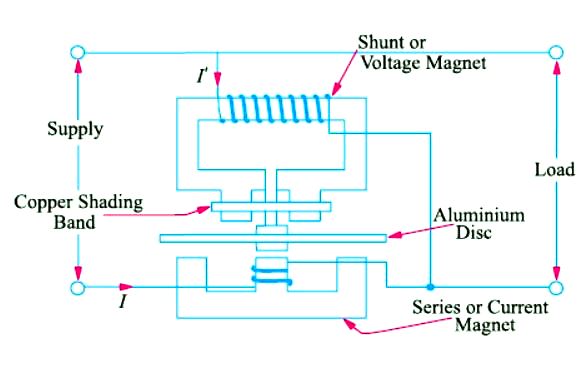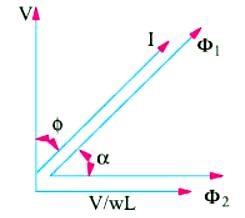Induction Type Wattmeters
The two main types of wattmeters are The dynamometer or electrodynamic type wattmeter and the induction type wattmeters.
Induction Type Wattmeters
Principle of induction type wattmeters is the same as that of induction type ammeters and voltmeters. They can be used on a.c. supply only in constant with dynamometer wattmeters, which can be used both on D.C. and A.C. supply. Induction wattmeters are useful only when the frequency and supply voltage are constant.
Since, both a current and a pressure element are required in such instrument, it is not essential to use the shaded-pole principle. Instead of this, two separate a.c. magnets are used, which produce two fluxes, which have the required phase difference.
Construction
The wattmeter has two laminated electromagnets, one of which is excited by the current in the main circuit-exciting winding being joined in series with the circuit, hence it is also called a series magnet. The other is excited by current which is proportional to the voltage of the circuit. Its exciting coil is joined in parallel with the circuit, hence this magnet is sometimes referred to as shunt magnet. A thin aluminium disc is so mounted that it cuts the fluxes of both magnets.
Hence, two eddy currents are produced in the disc. The deflection torque is produced due to the interaction of these eddy current and the inducing fluxes. Two or three copper rings are fitted on the central limb of the shunt magnet and can be so adjusted as to make the resultant flux in the shunt magnet lag behind the applied voltage by 90º.
Two most common forms of the electromagnets are shown in Figure A and Figure B. It is seen that in both cases, one magnet is placed above and the other below the disc. The magnets are so positioned and shaped that their fluxes are cut by the disc.

In Figure A, the two pressure coils are joined in series and are so wound that both send the flux through the central limb in the same direction. The series magnet carries two coils joined in series and so wound that they magnetise their respective cores in the same direction. Correct phase displacement between the shunt and series magnet fluxes can be obtained by adjusting the position of the copper shading bands as shown.
In the type of instrument shown in Figure B, there is only one pressure winding and one current winding. The two projecting poles of the shunt magnet are surrounded by a copper shading band whose position can be adjusted for correcting the phase of the flux of this magnet with respect to the voltage.
AdBlock-2
Both types of induction wattmeters shown above, are spring-controlled, the spring being fitted to the spindle of the moving system which also carries the pointer. The scale is uniformly even and extends over 300º.
Currents upto 100 A can be handled by such wattmeters directly but for currents greater than this value, they are used in conjunction with current transformers. The pressure coil is purposely made as much inductive as possible in order that the flux through it should lag behind the voltage by 90º.

Theory
The winding of one magnet carries line current I so that Φ1 ∝ I and is in phase with I (Figure C).
The other coil i.e., pressure or voltage coil is made highly inductive having an inductance of L and and negligible resistance. This is connected across the supply voltage V. The current in the pressure coil is therefore, equal to V/ωL. Hence, Φ2 ∝ V/ωL and lags behind the voltage by 90º. Let the load current I lag behind V by φ i.e., let the load power factor angle be φ. As shown in Figure A, the phase angle between Φ1 and Φ2 is α = (90 − φ). The value of the torque acting on the disc is given by
T = kω Φ1m Φ2m sin α ………. (Article induction type ammeters and voltmeters)
![]()
Hence, the torque is proportional to the power in the load circuit. For spring control,
the controlling torque Tc ∝ θ.
∴ θ ∝ power.
Hence, the scale is even.

Advantage and Limitations of Induction type Wattmeters
These wattmeters possess the advantages of fairly long scales (extending over 300º), are free from the effects of stray fields and have good damping. They are practically free from frequency errors. However, they are subject to (sometimes) serious temperature errors because the main effect of temperature is on the resistance of the eddy current paths.
Read article – Induction type ammeters and voltmeters
Visit NCERTplanet.com for NCERT solutions and Textbook downloads




